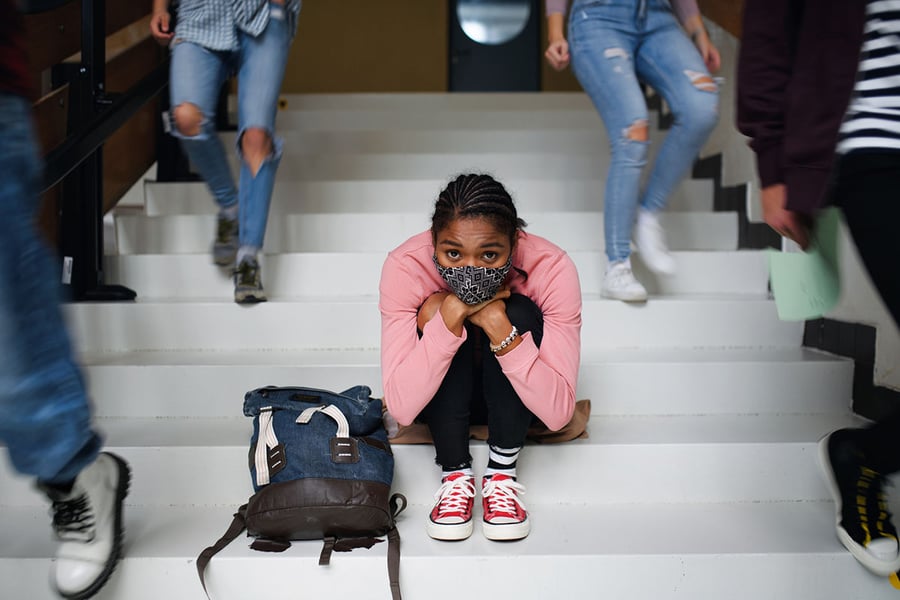Understanding the Effects of Trauma in Individuals and Communities
July 7, 2022 Posted by Jesse M. Ehrenfeld, MD, MPH

To explore more about the Advancing Behavioral Health Initiative, click here
Even before COVID-19 upended life as we knew it in early 2020, too many people were living with the effects of trauma.
Since then, we have experienced numerous national traumas: wildfires, police killings, school shootings. The list continues, and so do the effects of trauma.
These days, trauma is a fact of life for many Wisconsin communities, compounding existing inequities and issues.
What is the impact of traumatic events on the bodies and minds of our loved ones? And how can we help communities cope with the effects of trauma related to racism and poverty?
Trauma Explained
In a guide released from the Centers for Disease Control (CDC), trauma is described as an event or series of events that cause a lot of stress. “Traumatic events are marked by a sense of horror, helplessness, serious injury, or the threat of serious injury or death,” they write.
Trauma Response
Everyone reacts differently to trauma, but responses often include a constellation of issues, such as:
- Fear
- Grief
- Depression
- Nausea
- Dizziness
- Changes in appetite and/or sleep patterns
- Withdrawal from daily activities
Humans are resilient, and generally, people do start to feel better after a traumatic experience. But if any of the responses get worse or last longer than the month, the person may be experiencing post-traumatic stress disorder (PTSD).
What Is PTSD?
PTSD is a debilitating condition where people experience physical and emotional reminders of the traumatic event, sometimes years after it happened. The CDC divides symptoms of PTSD into 3 types:
- Re-living. This can include flashbacks, nightmares, or intensely emotional reactions like guilt, fear, or numbness. It also can cause physical symptoms like shaking, chills, heart palpitations, or headaches.
- Avoidance. People suffering from PTSD may devise ways of staying apart from others, and avoiding activities, places, thoughts or feelings that remind them of the traumatic event.
- Arousal. People with PTSD are often easily startled or on high alert. They may have trouble sleeping, feel angry or irritable, or have trouble concentrating.
That’s already a lot to happen inside one human. But PTSD has also been linked to panic attacks, depression, suicidal ideation, substance use, isolation, and having trouble completing daily tasks.
We need to do a better job of recognizing the symptoms of effects of trauma and PTSD, especially in children.
Children and Trauma
The Substance Abuse and Mental Health Services Administration (SAMHSA) has compiled some alarming statistics about the number of children who experience trauma. These national statistics show the following:
- More than ⅔ of children report at least one traumatic event by the time they are 16.
- More than 1 in 7 children have experienced abuse and/or neglect.
- Every single day, more than 1,000 young people go to emergency rooms for injuries related to assault.
- Each day, 14 young people die from homicide.
These are children living with trauma in their everyday lives. Add to their traumas the fear of experiencing the kinds of mass violence we have seen after mass shootings in Buffalo, New York, and Uvalde, Texas.
How can we identify signs of trauma to help young people get the help they need?
Age-related Trauma Indicators
Humans respond to trauma by putting up protective barriers as coping mechanisms. The National Child Traumatic Stress Network describes children’s trauma responses as “learned adaptations that make sense when physical and/or emotional threats are ever-present.”
Even after these adaptations are no longer helpful and interfere with important relationships, children and young people who have experienced trauma experience a number of issues, including learning difficulties, mental health challenges, involvement with the criminal justice system, and physical health problems.
That’s why it is so important to recognize and treat trauma early on.
Preschool children who have experienced trauma might
- Fear being separated from parents or caregivers
- Cry or scream a lot
- Lose weight
- Have nightmares
Elementary school children might
- Become anxious or fearful
- Experience guilt or shame
- Have trouble concentrating or sleeping
Middle and high school youth might
- Feel depressed or isolated
- Develop self-harming behaviors or eating disorders
- Start abusing substances
- Engage in risky sexual behavior
Trauma-informed medical and mental health practitioners are helping young people to recognize when their body goes into what is called “fight or flight.” It’s an alarm that protects us when we are in real danger, but can be reactivated as a trauma response.
Listening to the Alarms
SAMHSA recommends teaching young people to recognize the alarm and how it affects their bodies, decide whether there is immediate danger, and seek help from an adult they trust. Adults and children can learn to calm their nervous systems by practicing deep breathing and other meditation techniques.
Understanding Community Trauma
Trauma-informed care for individuals is one part of the puzzle, but it only goes so far.
In an important Prevention Institute publication by Rachel Davis and Howard Pinderhughes, the authors explore the widespread consequences of community trauma that is rooted in our society’s violence and inequities.
“Community trauma is the common experience of chronic adversity from systemic factors like discrimination, racism, sexism, poverty, and oppression,” the authors write. “In communities with high rates of violence, trauma is not just a problem for the individuals who directly witness or experience violence. Service providers, first responders and residents in high-violence communities also experience trauma, including vicarious trauma.”
In addition, structural violence that disenfranchises people of color and low-income people results in high levels of trauma, causing damage to relationships and communities.
Trauma Resources in Wisconsin
Here in Wisconsin, there are a number of resources available to address both individual and community trauma.
-
Resilient Wisconsin is a project of the Wisconsin Department of Health Services aimed at helping people adapt and recover from adversity. It includes self-care and stress-reduction tips and connects people to trauma-informed resources.
-
The Wisconsin Safe and Healthy Schools Center’s Trauma Sensitive Schools project offers practical advice for students and staff coping with trauma, including pandemic-related difficulties. They have resources for addressing substance use issues, bullying, internet safety, equity, and more.
-
Wisconsin Connect has compiled trauma-informed and responsive resources, including video, slide shows, and organizations.
-
Medical College of Wisconsin’s Comprehensive Injury Center offers a number of trauma-informed resources, including “The ‘S’ Word: Suicide and Mental Health, a podcast from Sara Kohlbeck and Andrew Schramm of the Division of Suicide Prevention.
AHW-Funded Projects
As part of our goal to create a healthier Wisconsin, the Advancing a Healthier Wisconsin Endowment has funded a number of projects that address trauma.
-
Workforce Resource, Inc. is a community organization working to integrate trauma screening and intervention into the services offered by Wisconsin Works (W-2), the Wisconsin Department of Children and Families program that provides employment guidance, case management, and cash assistance to women and parents who are low-income.
-
Remembering the Lost: How Investigation of Military Suicides Can Improve Prevention Resources addresses the high number of veterans who die by suicide every year. The aim is to improve data collection and understanding of the life circumstances that result in these deaths.
A Big Investment in Behavioral Health
We need all hands on deck to address the trauma and inequity experienced by Wisconsin residents.
The Advancing Behavioral Health Initiative is AHW’s eight-year, up to $20 million commitment to advance mental and behavioral health outcomes in 10 Wisconsin communities.
The initiative is taking a strategic approach, combining funding with the resources, time, and supports that partners need to develop strategies, put them into action, and evaluate their impact for sustainable change.
When the medical community, coalitions, and government work together to address the effects of trauma, we move closer to our goal of a healthier Wisconsin.



.png?width=300&name=Replacement%20Header_Sized_PH%20Blog%20(2).png)
